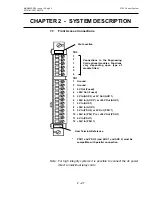
3 - 6
CHAPTER 3 CONTROLS AND FACILITIES
MAN0443.P65 Issue 13 Aug 04
5701 Control System
05701-M-5001 A02279
m.
Falling Alarm
A falling alarm is caused by a falling level of the parameter being
measured crossing a preconfigured threshold and will also cause
the associated alarm LED to illuminate.
n.
Latched Alarm
A latched alarm is an alarm that will remain active even though the
level monitored no longer crosses the alarm threshold. The alarm
LED will remain lit until the alarm reset is operated.
o.
Non-latched Alarm
A non-latched alarm is an alarm that only remains active while the
level being monitored crosses the alarm threshold. The alarm LED
will remain lit while the alarm level remains but will automatically be
reset when the level monitored no longer crosses the alarm threshold.
p.
Normally Energised
A normally energised relay is activated when the power is removed
from it, (eg. in the event of a system power failure). The LEDs will
illuminate when an alarm or fault condition occurs irrespective of the
relay configured state.
q.
Normally De-energised
A normally de-energised relay is activated when the power is applied
to it, (eg. in the event of an alarm condition). The LEDs will illuminate
when an alarm or fault condition occurs irrespective of the relay
configured state.
r.
Time Delay Alarms (Version 2V
x
Software only)
The operation in response to alarm events of certain relays may be
modified by applying a delay function to the relays. Time delay functions
are available to delay the activation of a relay for a short period after
an alarm event occurs and/or to maintain relay activation for a period
after the alarm event has cleared. The time delay facilities are available
for relays RL2 to RL8 of the High Integrity Relay Card only.
The time delay function is useful to prevent spurious alarms and to
ensure appropriate minimum operating times for external electrical
apparatus connected to the relay.
















































